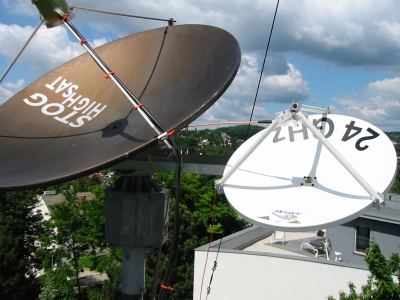
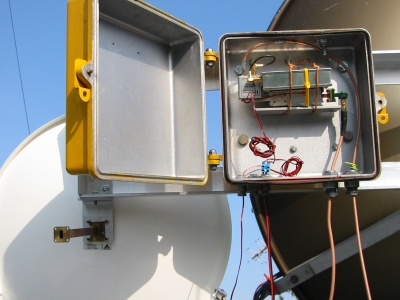
The 24 GHz dish is mounted next to an 1.2 m dish (S-band) on a JRC/EGIS HAM antenna rotator. Due to some mechanical damage the 1.2 m dish turned out to be unusable on 24 GHz, while it is quite reasonable on 2.4 GHz.


The limiting behaviour of the K-Tx path causes a lot of disturbances of the beacon by other stations (using the S band downlink) in the passband. CW signals were chopping the beacon signal dramatically and SSB signals were distorting it, sometimes the beacon was disappearing completely in the noise, while the other stations were still R 5.
The influence of the squint angle on signal strength is not as obvious as one would expect. The squint angle was calculated from the Alon/Alat figures given in the header of the telemetry A-blocks. These did not always agree exactly with the (more precise ?) figures from the YACE. YACE was activated always on orbits, when the K-band activity was not in the visible range from Europe. Therefore a direct comparison was not possible. Second, the antenna rotator is not as precise as one would expect. Since the elevation is controlled by a linear motion, some minor deviations of the elevation display occur. A full calibration of the display versus actual antenna direction has not been done. Due to the changing signal strength of the beacon an optimisation of the signal was not always very easy and probably not precise enough. For reasonable communications with a .5 m dish, the squint angle should be less than five degrees.
Finally, a weather report should be included in any description of K-band activities. Rain and snow make K-band activities definitely impossible, clouds and fog will have a significant impact.
Date Orbit# K-Tx on Alon/ Squint Beacon min/max Remarks
MA Alat range/ S/(S+N) dB
trend passband single
2003-08-12 1277 124/126/134 3/0 2-5 4-10
-13 1278 3/-2
-16 1282 126/132/134 5/1
-17 1283 7/3 5.4->3.7 QSO JA1ADN(rcv S)
-19 1286 5/2
-20 1287 5/2
-21 1288 7/2 5.6->4.0 QSO VK5DG(rcv S)
-24 1292 2/4 0 0-2
-25 1293 4/3 2.5->1.6 0-3 2-4
-09-05 1307 0/1 3-6 5-10
-05 1308 ?/? 3-6 4-9 own downlink 3
-08 1311 -1/0 0-1 2-5
-09 1312 1/-1 2-4 3-7
-09 1313 1/-1 Table 1
-12 1316 0/0 5.9->4.5 0-4 2-5
-16 1321 0/0 5.9->4.2 0-2 2-5
-17 1322 2/0 4.9->4.2 4-7 6-10 SSB stations 5-6
-20 1326 1/2 5.8->4.1 0-4 6-9 min.squ. 1.7 MA148
-21 1327 4/1 5.9->4.3 2-5 5-8 own downlink 2-3
-24 1331 1/0 6.5->5.0 0-1 1-3
-25 1332 3/0 5.2->4.3 2-6 4-8 own downlink 3-4
-28 1336 3/1 8.2->6.0 0-2 4-7
-29 1337 4/0 4.3->3.3 3-7 6-10 own downlink 3-4
-10-02 1341 2/0 7.1->5.7 0-3 3-7
-03 1342 4/0 5.6->4.6 3-6 5-10 3 tlm blocks CRC Ok
-06 1346 5/2 9.1->7.3 0-2 3-6 min.squ. 1.9 MA162
-11 1353 174/176/184 18/0 5.1<->4.9 0-3 3-6
-15 1357 13/1 3.4-3.7 2-6 5-6 own downlink 2-3
-15 1358 14/-1 6.2->8.1 0-1 1-2
-19 1362 21/0 9.9->7.7 0-6 2-5
-22 1366 20/0 12.4->9.7 0 0 cloudy
-23 1368 21/0 0 rain, snow
-26 1371 20/2 0
-27 1373 24/1 8.5->5.7 2-5 clear
-30 1376 23/0 15.0->12.2 0 0 rain, fog
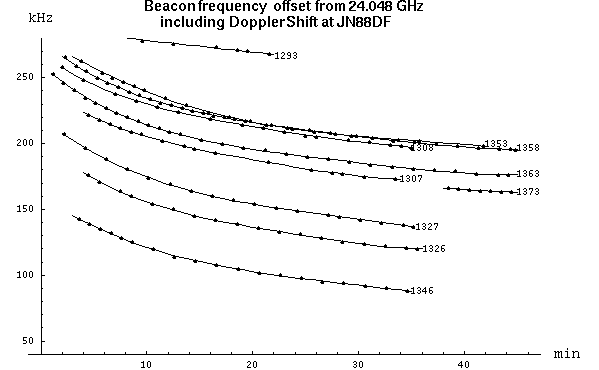 Figure 1
Figure 1
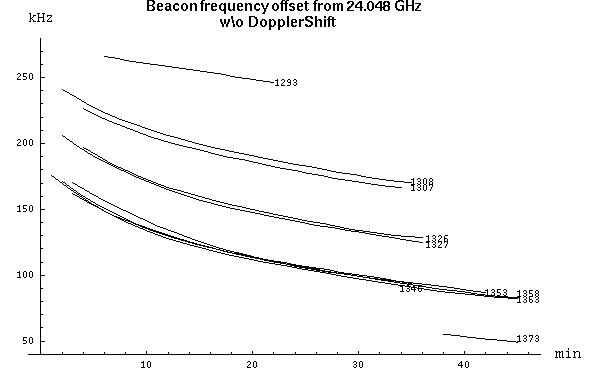 Figure 2
Figure 2
The drift during each orbit can certainly be interpreted as a negative temperature drift, showing the warming up of the transmitter. There is no temperature sensor near the K-Tx and therefore we can but roughly compare the temperature of the satellite, represented by the heat pipes. Figure 3 shows the temperature of the ends of two heat pipes (telemetry data at the beginning of the K-band activity, MA 124 and 174 respectively), and we see quite a good match with the beacon drift. Especially the behaviour between orbits 1346 and 1363 gives a strong indication. May be, during the next activation period the temperature drift of the satellite will be different, and we can verify this hypothesis.
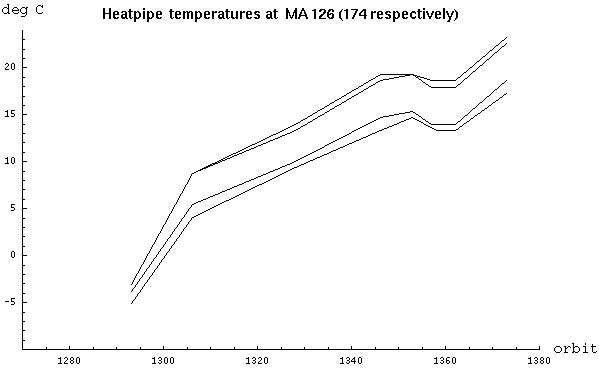 Figure 3
Figure 3
 Figure 4
Figure 4
And finally we should try to separate S-band and K-band downlinks - switching off S-band is certainly not an option. How about promoting a slogan like "AO-40 S-beacon +/-40 kHz, 24 GHz-beacon +/-12 kHz" ?
New: 2003-11-11